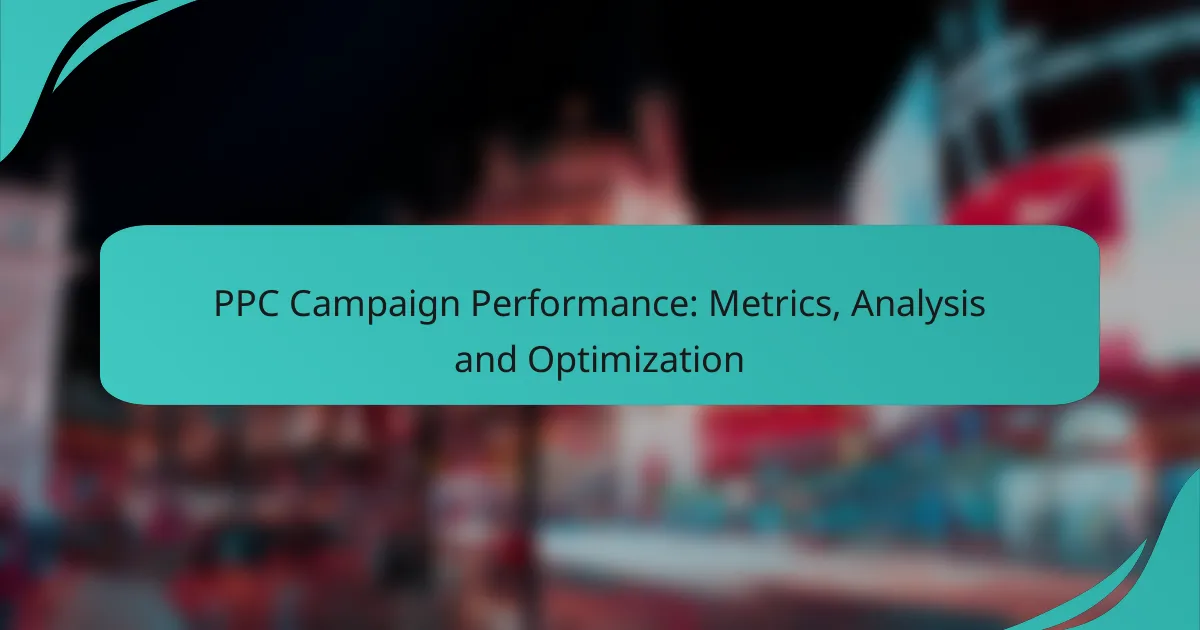Effective PPC campaign performance hinges on a thorough understanding of key metrics such as click-through rates, cost per click, and conversion rates. By analyzing these metrics, marketers can make data-driven decisions that enhance campaign effectiveness and optimize bidding strategies. Continuous testing and refinement are essential for achieving improved results and maximizing return on ad spend.

How to improve PPC campaign performance in the UK?
Improving PPC campaign performance in the UK involves refining your strategies to enhance click-through rates, reduce irrelevant traffic, and optimize bidding. Focus on data-driven decisions and continuous testing to achieve better results.
Optimize ad copy for higher click-through rates
To increase click-through rates (CTR), your ad copy must be compelling and relevant. Use clear calls to action, highlight unique selling points, and incorporate keywords that resonate with your target audience.
Consider using emotional triggers or urgency in your messaging. Phrases like “limited time offer” or “exclusive deal” can encourage users to click. Regularly review and update your ad copy to keep it fresh and aligned with current trends.
Utilize negative keywords to reduce irrelevant traffic
Negative keywords help filter out unwanted traffic by preventing your ads from showing for specific search terms. This ensures that your budget is spent on clicks that are more likely to convert.
Regularly analyze your search term reports to identify irrelevant queries and add them as negative keywords. This practice can significantly improve your campaign’s efficiency and overall ROI.
Adjust bidding strategies based on performance data
Monitoring and adjusting your bidding strategies is crucial for maximizing PPC performance. Use performance data to identify which keywords and ads are delivering the best results, and allocate your budget accordingly.
Consider employing automated bidding strategies, such as target CPA or target ROAS, to optimize bids based on real-time data. This can help you maintain competitiveness while managing costs effectively.
Implement A/B testing for landing pages
A/B testing landing pages allows you to determine which design or content variations lead to higher conversion rates. By comparing two or more versions of a landing page, you can identify what resonates best with your audience.
Focus on elements like headlines, images, and calls to action. Make sure to test one variable at a time for clear results. Implementing successful changes can lead to improved PPC performance and better return on investment.

What key metrics should be analyzed in PPC campaigns?
Key metrics in PPC campaigns include click-through rate (CTR), cost per click (CPC), conversion rate, and return on ad spend (ROAS). Analyzing these metrics helps assess the effectiveness of your campaigns and guides optimization efforts for better performance.
Click-through rate (CTR)
Click-through rate (CTR) measures the percentage of users who click on your ad after seeing it. A higher CTR indicates that your ad is relevant and appealing to your target audience. Aim for a CTR of around 2-5% as a benchmark, but this can vary by industry.
To improve CTR, focus on crafting compelling ad copy and using targeted keywords. Regularly test different ad variations to see which resonates best with your audience. Avoid generic messaging that fails to engage users.
Cost per click (CPC)
Cost per click (CPC) represents the amount you pay each time someone clicks on your ad. Understanding CPC is crucial for budgeting and determining the profitability of your campaigns. Typical CPCs can range from a few cents to several dollars, depending on the competitiveness of your keywords.
To manage CPC effectively, consider using negative keywords to filter out irrelevant traffic and optimize your bids based on performance. Monitor your CPC regularly to ensure it aligns with your overall marketing goals and budget constraints.
Conversion rate
The conversion rate measures the percentage of users who complete a desired action after clicking on your ad, such as making a purchase or signing up for a newsletter. A higher conversion rate indicates that your landing page and offer are effective. Aim for a conversion rate of 2-5%, but this can differ based on the industry and campaign type.
To boost conversion rates, ensure your landing pages are relevant, user-friendly, and optimized for mobile devices. A/B testing different landing page elements can help identify what drives higher conversions. Avoid overly complicated forms that may deter potential customers.
Return on ad spend (ROAS)
Return on ad spend (ROAS) measures the revenue generated for every dollar spent on advertising. A ROAS of 4:1 is often considered a good target, meaning you earn four dollars for every dollar spent. This metric helps evaluate the financial effectiveness of your PPC campaigns.
To improve ROAS, focus on optimizing your ad targeting and refining your bidding strategies. Regularly analyze which campaigns and keywords yield the highest returns and allocate more budget to those areas. Avoid overspending on underperforming ads to maintain a healthy ROAS.

How to analyze PPC campaign performance effectively?
To analyze PPC campaign performance effectively, focus on key metrics such as click-through rates, conversion rates, and return on ad spend. Regularly reviewing these metrics allows for informed adjustments to improve overall campaign effectiveness.
Use Google Ads reporting tools
Google Ads offers comprehensive reporting tools that provide insights into campaign performance. Utilize features like the performance report, which breaks down metrics by ad group, keyword, and device, helping identify strengths and weaknesses.
To maximize the benefits, set up custom reports tailored to your specific goals. This allows for a more focused analysis on metrics that matter most to your business, such as cost per acquisition or average position.
Segment data by demographics and location
Segmenting data by demographics and location is crucial for understanding your audience better. By analyzing performance based on age, gender, and geographical location, you can tailor your campaigns to target the most responsive segments.
For example, if your ads perform significantly better in urban areas compared to rural ones, consider reallocating your budget to focus more on those locations. This targeted approach can lead to improved conversion rates and a higher return on investment.
Compare performance against industry benchmarks
Comparing your PPC performance against industry benchmarks is essential for evaluating your campaign’s effectiveness. Research typical metrics for your industry, such as average click-through rates or conversion rates, to gauge where you stand.
For instance, if the average conversion rate in your sector is around 3%, and your campaign is achieving only 1%, it may indicate the need for optimization. Use this comparison to identify gaps and set realistic performance goals for your campaigns.

What are the best practices for PPC optimization?
Effective PPC optimization involves regularly refining your campaigns to improve performance and return on investment. Key practices include adjusting keyword targeting, monitoring competitors, and leveraging remarketing strategies to re-engage previous visitors.
Regularly review and adjust keyword targeting
Keyword targeting is crucial for PPC success. Regularly analyze the performance of your keywords, focusing on metrics like click-through rates and conversion rates to identify which keywords are effective and which are not. Consider pausing or removing underperforming keywords and adding new ones based on search trends.
Utilize tools like Google Ads Keyword Planner to discover high-potential keywords. Aim for a mix of broad, phrase, and exact match types to capture diverse search intents while maintaining relevance. Regular adjustments can lead to improved ad placements and lower costs per click.
Monitor competitor strategies in the UK market
Keeping an eye on competitor strategies is essential in the competitive UK PPC landscape. Analyze their ad copy, keywords, and landing pages to identify successful tactics that you can adapt. Tools like SEMrush or SpyFu can provide insights into competitor bidding strategies and keyword choices.
Be aware of seasonal trends and promotional events that competitors may leverage. Adjust your bids and ad messaging accordingly to stay competitive and capture market share, especially during peak shopping seasons.
Leverage remarketing campaigns for previous visitors
Remarketing campaigns are a powerful way to re-engage users who have previously visited your site but did not convert. By displaying targeted ads to these users across various platforms, you can remind them of your offerings and encourage them to return. Set up remarketing lists based on user behavior, such as pages visited or actions taken.
Consider segmenting your remarketing audience to tailor your messaging effectively. For instance, offer special discounts to users who abandoned their carts or promote new products to those who viewed specific categories. This personalized approach can significantly boost conversion rates and maximize your PPC investment.

What tools can assist in PPC campaign analysis?
Several tools can enhance PPC campaign analysis by providing insights into performance metrics, competitor strategies, and traffic sources. Utilizing these tools effectively can lead to better decision-making and improved campaign outcomes.
Google Analytics for traffic insights
Google Analytics is essential for understanding traffic patterns and user behavior on your website. It allows you to track key metrics such as sessions, bounce rates, and conversion rates, which are crucial for evaluating the effectiveness of your PPC campaigns.
To maximize its utility, set up goals that align with your campaign objectives. For example, if your goal is to increase sales, monitor the conversion rate for specific landing pages linked to your ads. Regularly review these metrics to identify trends and areas for improvement.
SEMrush for competitive analysis
SEMrush provides valuable insights into your competitors’ PPC strategies, enabling you to benchmark your performance against industry standards. You can analyze competitors’ ad copy, keywords, and budget estimates, which helps in refining your own campaigns.
Use SEMrush to identify high-performing keywords that your competitors are targeting. This can inform your keyword strategy and help you discover gaps in your own campaigns. Additionally, keep an eye on changes in competitor spending to adjust your bids and budgets accordingly.








